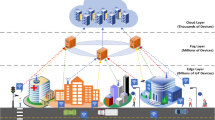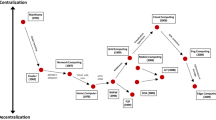Abstract
Fog computing needs, particularly in terms of performance, availability and reliability, are increasing every day due to the rapid growth in the number of connected Internet of Things devices and, consequently, the quantitative explosion in the volume of data generated. This study aims to improve the management of collected data to maximize the performance of Fog computing. To this end, a dynamic architecture for the distributed storage of collected data in Fog environments, based on Fog collaboration, is proposed. Dynamicity is related to the Fog and sensors mobility, but distribution is related to data storage in Fog computing resources. In addition, a supplementary Fog layer and a Fog assignment table are used for a good achievement of the proposed architecture and efficient management of Fog sensor associations. The simulation experiments show that the collaborative distributed storage significantly improves the performance of the Fog in terms of data availability and end-user latency. Subsequently, the proposed solution minimizes the number of queries to the cloud.








Similar content being viewed by others
References
Chiang, M., & Zhang, T. (2016). Fog and IoT: An overview of research opportunities. IEEE Internet of Things Journal, 3(6), 854–864. https://doi.org/10.1109/JIOT.2016.2584538
Chang, C., Srirama, S. N., & Buyya, R. (2019). Internet of Things (IoT) and new computing paradigms. Fog and Edge Computing: Principles and Paradigms, 1, 1–23. https://doi.org/10.1002/9781119525080.ch1
Pallavi, K. N., & Kumar, V. R. (2020). Authentication-based access control and data exchanging mechanism of IoT devices in fog computing environment. Wireless Personal Communications, 1, 1. https://doi.org/10.1007/s11277-020-07834-w
Steffenel, L. A. (2018). Improving the performance of fog computing through the use of data locality. In 30th International Symposium on Computer Architecture and High Performance Computing (SBAC-PAD), Lyon, France (pp. 217–224). https://doi.org/10.1109/CAHPC.2018.8645879.
Mahmood, Z., & Ramachandran, M. (2018). Fog computing: Concepts, principles and related paradigms. Fog Computing: Concepts, Frameworks and Technologies, 1, 1. https://doi.org/10.1007/978-3-319-94890-4
Pereira, P., Araujo, J., Torquato, M., Dantas, J., Melo, C., & Maciel, P. (2020). Stochastic performance model for web server capacity planning in Fog computing. The Journal of Supercomputing, 76, 9533–9557. https://doi.org/10.1007/s11227-020-03218-w
Margariti, S. V., Dimakopoulos, V. V., & Tsoumanis, G. (2020). Modeling and Simulation Tools for Fog Computing-A Comprehensive Survey from a Cost Perspective. Future Internet, 12(5), 89. https://doi.org/10.3390/fi12050089
Naha, R. K., Garg, S. K., & Chan, A. (2018). Fog computing architecture: Survey and challenges. Big Data-Enabled Internet of Things, 1, 199–223. https://doi.org/10.1049/PBPC025E_ch10
Hussain, M. M., Beg, M. M. S., & Alam, M. S. (2020). Fog computing for big data analytics in IoT aided smart grid networks. Wireless Personal Communications, 114, 3395–3418. https://doi.org/10.1007/s11277-020-07538-1
Markus, A., & Kertesz, A. (2020). A survey and taxonomy of simulation environments modelling Fog computing. Simulation Modelling Practice and Theory, 101, 102042. https://doi.org/10.1016/j.simpat.2019.102042
Hong, C., & Varghese, B. (2019). Resource management in fog/edge computing: A survey on architectures, infrastructure, and algorithms. ACM Computing Surveys, 52(5), 1–37. https://doi.org/10.1145/3326066
Yousefpour, A., Fung, C., Nguyen, T., Kadiyala, K., Jalali, F., Niakanlahiji, A., Kong, J., & Jue, J. P. (2019). All one needs to know about Fog computing and related edge computing paradigms: A complete survey. Journal of Systems Architecture, 98, 289–330. https://doi.org/10.1016/j.sysarc.2019.02.009
Ai, Y., Peng, M., & Zhang, K. (2018). Edge computing technologies for Internet of Things: A primer. Digital Communications and Networks, 4(2), 77–86. https://doi.org/10.1016/j.dcan.2017.07.001
Vales, R., Moura, J., & Marinheiro, R. (2019). Energy-aware and adaptive Fog storage mechanism with data replication ruled by spatio-temporal content popularity. Journal of Network and Computer Applications, 135, 84–96.
Ran, R., Kumar, N., Khurana, M., Kumar, A., Barnawi, A. (2021). Storage as a service in Fog computing: A systematic review. Journal of Systems Architecture.
Hu, P., Dhelim, S., Ning, H., & Qiu, T. (2017). Survey on fog computing: Architecture, key technologies, applications and open issues. Journal of Network and Computer Applications, 98, 27–42.
Sharma, P. K., Chen, M. Y., & Park, J. H. (2018). A software defined fog node based distributed blockchain cloud architecture for IoT. IEEE Access, 6, 115–124. https://doi.org/10.1109/ACCESS.2017.2757955
Kim, D., Son, J., Seo, D., Kim, Y., Kim, H., & Seo, J. T. (2020). A novel transparent and auditable Fog-assisted cloud storage with compensation mechanism. Tsinghua Science and Technology, 25(1), 28–43. https://doi.org/10.26599/TST.2019.9010025
Benhamida, N., Bouallouche-Medjkoune, L., Aïssani, D., & Lafifi, Y. (2017). Improving the Quality of Mobile Learning Services. Wireless Personal Communications, 97(4), 5305–5324.
Kemme, B. (2009). Data replication. In Liu, L., Özsu, M. T. (Eds.) Encyclopedia of database systems. Springer. https://doi.org/10.1007/978-0-387-39940-9_110.
Wang, Q. J. (2017). Fundamental concepts of distributed computing used in big data analytics, distributed computing in big data analytics: Concepts, technologies and applications. Scalable Computing and Communications. https://doi.org/10.1007/978-3-319-59834-5
Amato, A. (2017). On the role of distributed computing in Big Data analytics, distributed computing in big data analytics: Concepts, technologies and applications. Scalable Computing and Communications. https://doi.org/10.1007/978-3-319-59834-5.
Yousefpour, A., Ishigaki, G., & Jue, J. P. (2017). Fog computing: Towards minimizing delay in the Internet of Things. In IEEE International Conference on Edge Computing (EDGE), Honolulu, HI (pp 17–24). https://doi.org/10.1109/IEEE.EDGE.2017.12.
Naha, R. K., Garg, S., Georgakopoulos, D., Jayaraman, P. P., Gao, L., Xiang, Y., & Ranjan, R. (2018). Fog computing: Survey of trends, architectures, requirements, and research directions. IEEE Access, 6, 47980–48009. https://doi.org/10.1109/ACCESS.2018.2866491.10.1109/ACCESS.2018.2866491
Dua, D., & Graff, C. (2019). UCI Machine Learning Repository [http://archive.ics.uci.edu/ml]. Irvine, CA: University of California, School of Information and Computer Science.
Benhamida, N., Bouallouche-Medjkoune, L., & Aïssani, D. (2018). Simulation evaluation of a relative frequency metric for web cache replacement policies. Evolving Systems, 9(3), 245–254.
Author information
Authors and Affiliations
Corresponding author
Additional information
Publisher's Note
Springer Nature remains neutral with regard to jurisdictional claims in published maps and institutional affiliations.
Rights and permissions
About this article
Cite this article
Benhamida, N., Bouallouche-Medjkoune, L., Aïssani, D. et al. Dynamic Architecture for Collaborative Distributed Storage of Collected Data in Fog Environments. Wireless Pers Commun 123, 3511–3537 (2022). https://doi.org/10.1007/s11277-021-09301-6
Accepted:
Published:
Issue Date:
DOI: https://doi.org/10.1007/s11277-021-09301-6




